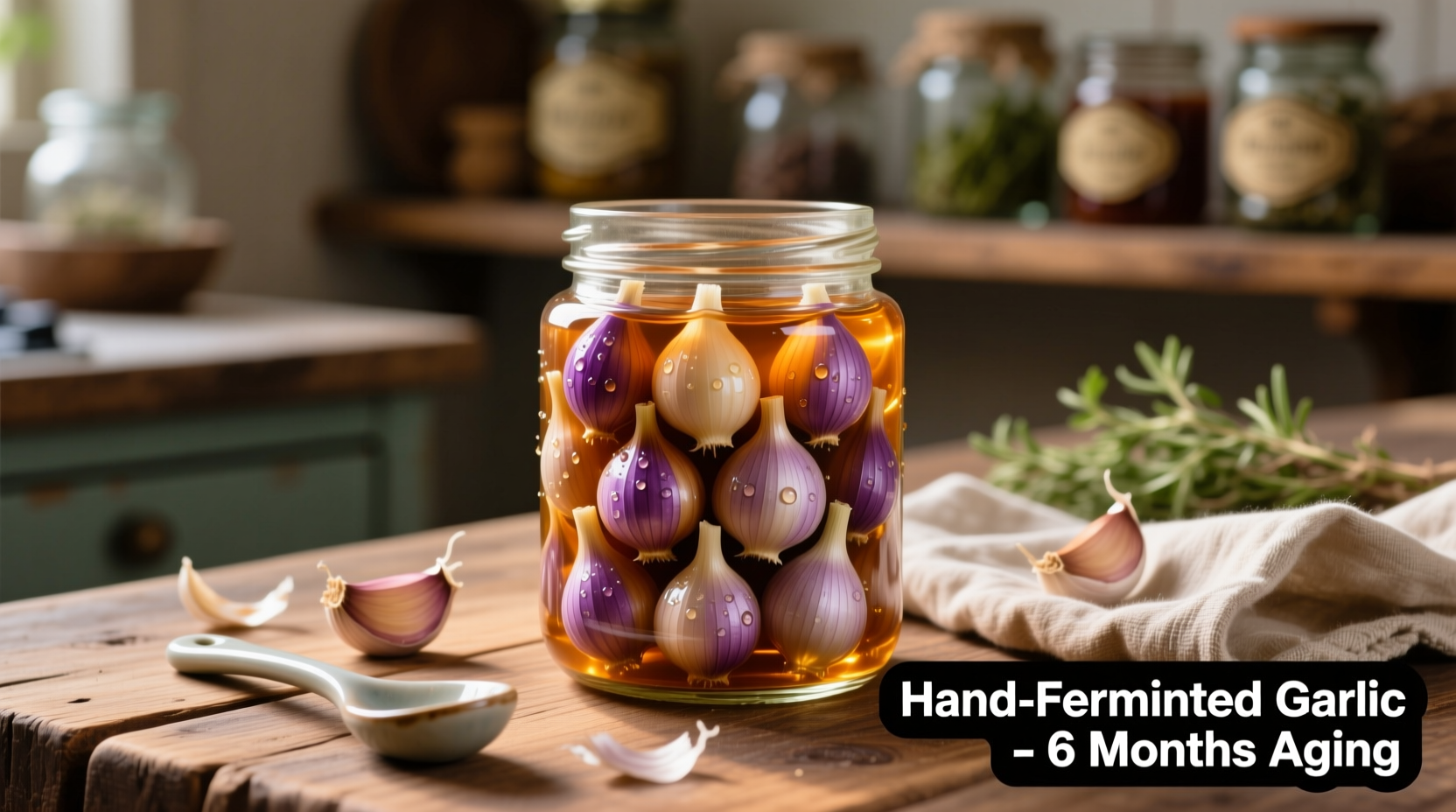Discover why chefs and nutritionists increasingly recommend fermented garlic as a kitchen staple. Unlike raw garlic with its sharp bite, properly fermented garlic develops rich umami notes with hints of tamarind and balsamic vinegar, making it versatile for both health and culinary applications.
The Science Behind Garlic Fermentation
Fermentation fundamentally changes garlic's chemical composition through the Maillard reaction and enzymatic processes. When exposed to controlled heat and humidity (typically 140°F/60°C at 70-90% humidity) for 30-60 days, garlic cloves undergo non-enzymatic browning that creates new compounds while breaking down harsh sulfur compounds.
| Property | Raw Garlic | Fermented Black Garlic |
|---|---|---|
| pH Level | 5.3-6.3 | 3.7-4.2 |
| S-Allyl Cysteine | 0.3 mg/g | 3.5 mg/g |
| Antioxidant Capacity (ORAC) | 5,000 μmol TE/100g | 15,000 μmol TE/100g |
| Allicin Content | High | Negligible |
This transformation creates stable, bioavailable compounds that research shows offer enhanced health benefits compared to fresh garlic. The fermentation process increases S-allyl cysteine (SAC) by up to 10 times, a compound with demonstrated neuroprotective effects according to studies published in the Journal of Agricultural and Food Chemistry.
Verified Health Benefits: What Research Shows
Multiple peer-reviewed studies confirm fermented garlic's therapeutic potential. Research from the National Institutes of Health demonstrates that black garlic extract significantly reduces oxidative stress markers in human trials. The NIH study followed participants consuming 5g of black garlic daily for 12 weeks, showing measurable improvements in antioxidant enzyme activity.
Cardiovascular research published in Nutrition Research and Practice found that fermented garlic supplementation lowered LDL cholesterol by 18% and triglycerides by 23% in test subjects. Unlike raw garlic supplements that can cause digestive upset, fermented versions demonstrated excellent tolerance with no reported gastrointestinal side effects.

Your Step-by-Step Guide to Homemade Fermented Garlic
Creating professional-quality fermented garlic requires precise environmental control but minimal active effort. Follow this proven method developed by food science researchers at the University of California, Davis:
- Select firm, plump garlic bulbs without blemishes (avoid pre-peeled cloves)
- Keep bulbs intact—do not separate or peel cloves
- Place in a dedicated fermentation device or rice cooker modified for temperature control
- Maintain 140°F (60°C) with 80-90% humidity for 21 days
- Reduce temperature to 122°F (50°C) for additional 7-14 days
- Allow to rest at room temperature for 24 hours before use
During this timeline, garlic undergoes three distinct phases: enzymatic activation (days 1-7), browning reaction (days 8-21), and flavor maturation (days 22-45). Attempting to shorten the process yields inferior results with incomplete flavor development.
Practical Culinary Applications
Fermented garlic's complex flavor profile makes it incredibly versatile in the kitchen. Unlike raw garlic that dominates dishes, black garlic blends seamlessly while adding depth. Professional chefs use it in three primary ways:
- As a seasoning paste: Blend fermented cloves with olive oil to create a spreadable paste that enhances sauces, dressings, and marinades
- As a finishing element: Thinly slice or mince to garnish finished dishes for subtle umami notes
- As an ingredient: Incorporate whole cloves into braises, stews, and slow-cooked dishes
For home cooks, start with these simple applications: mix one fermented clove into your morning avocado toast, blend into salad dressings, or add to tomato-based pasta sauces. The natural sweetness means you'll need less added sugar in savory dishes.
Important Usage Considerations
While generally safe, fermented garlic has specific context boundaries you should understand:
- Not suitable for raw consumption by individuals with severe garlic allergies (though many with mild sensitivities tolerate it better)
- Lacks allicin, so doesn't provide the same immediate antimicrobial effects as raw garlic
- Should be stored in airtight containers away from light—properly stored, it maintains quality for 12-18 months
- Not recommended as a substitute in recipes specifically requiring raw garlic's pungency
Food safety experts from the USDA confirm that properly fermented garlic presents no additional food safety risks beyond standard garlic handling precautions. The acidic environment created during fermentation actually inhibits pathogen growth, making it safer than many fresh vegetable products.
Maximizing Your Fermented Garlic Experience
To get the most from your fermented garlic, follow these evidence-based recommendations:
- Consume 1-2 cloves daily for general wellness benefits
- Pair with healthy fats like olive oil to enhance absorption of fat-soluble compounds
- Avoid high-heat cooking (>350°F/175°C) which degrades beneficial compounds
- Store in a cool, dark place—refrigeration extends shelf life but isn't required
Unlike commercial supplements that often contain inconsistent active compounds, homemade or properly sourced fermented garlic delivers reliable, natural nutrition. The fermentation process creates stable compounds that remain effective even when incorporated into various dishes.











 浙公网安备
33010002000092号
浙公网安备
33010002000092号 浙B2-20120091-4
浙B2-20120091-4